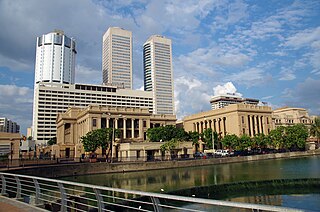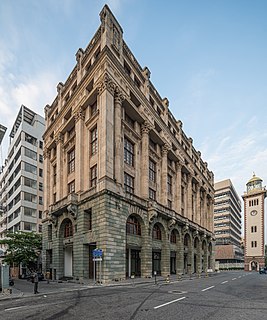
Colombo is the commercial capital and largest city of Sri Lanka by population. According to the Brookings Institution, Colombo metropolitan area has a population of 5.6 million, and 752,993 in the Municipality. It is the financial centre of the island and a tourist destination. It is located on the west coast of the island and adjacent to the Greater Colombo area which includes Sri Jayawardenepura Kotte, the legislative capital of Sri Lanka, and Dehiwala-Mount Lavinia. Colombo is often referred to as the capital since Sri Jayawardenepura Kotte is itself within the urban/suburban area of Colombo. It is also the administrative capital of the Western Province and the district capital of Colombo District. Colombo is a busy and vibrant city with a mixture of modern life, colonial buildings and monuments.

Anuradhapura is a major city in Sri Lanka. It is the capital city of North Central Province, Sri Lanka and the capital of Anuradhapura District. Anuradhapura is one of the ancient capitals of Sri Lanka, famous for its well-preserved ruins of an ancient Sinhala civilisation. It was the third capital of the kingdom of Rajarata, following the kingdoms of Tambapanni and Upatissa Nuwara.

Tourism in Sri Lanka is growing rapidly. For centuries, Sri Lanka has been a popular place of attraction for foreign travelers. The Chinese traveler Fa-Hien visited Sri Lanka as early as the 410's AD/CE, and in the twelfth century, Italian explorer Marco Polo claimed Sri Lanka to be the "best island of its size in the world".
The University of Colombo is a public research university located primarily in Colombo, Sri Lanka. It is the oldest institution of modern higher education in Sri Lanka. Specialised in the fields of natural, social, and applied sciences as well as mathematics, computer sciences, and law. It is ranked among the top 10 universities in South Asia.

Education in Sri Lanka has a long history that dates back two millennia. While the Constitution of Sri Lanka does not provide free education as a fundamental right, the constitution mentions that 'the complete eradication of illiteracy and the assurance to all persons of the right to universal and equal access to education at all levels" in its section on directive principles of state policy at (27. Sri Lanka's population had an adult literacy rate of 96.3% in 2015, which is above average by world and regional standards. Computer literacy in 2017 28.3% and phone users in 2017 105%, website users 32% in 2017. Education plays a major part in the life and culture of the country, which dates back to 543 BC. Sri Lanka's modern educational system modeled after Christian missionary system was brought about by its integration into the British Empire in the 19th century. Education currently falls under the control of both the Central Government and the Provincial Councils, with some responsibilities lying with the Central Government and the Provincial Council having autonomy for others. Education institutions with a tradition dating back to 5 BC are largely ignored by the state.

The University of Peradeniya is a public university in Sri Lanka, funded by the University Grants Commission. It is the largest university in Sri Lanka, which was originally established as the University of Ceylon in 1942. The university was officially opened on 20 April 1954 in the presence of Queen Elizabeth II by Prince Philip, Duke of Edinburgh.

S. Thomas' College, Mount Lavinia,(abbreviated as STC), is a fee levying Anglican selective entry boys' private school in Sri Lanka. Started as a private school by Rt. Rev. James Chapman, the first Anglican Bishop of Colombo, in 1851, it was founded as a college and cathedral for the new Diocese of Colombo of the Church of Ceylon, modelled on British Public school tradition. An old boy of Eton College, Bishop Chapman founded the college on the Etonian model, the school's motto of Esto Perpetua being derived from that of Eton College.

Galle Face is a 5 ha ocean-side urban park, which stretches for 500 m (1,600 ft) along the coast, in the heart of Colombo, the financial and business capital of Sri Lanka. The promenade was initially laid out in 1859 by Governor Sir Henry George Ward, although the original Galle Face Green extended over a much larger area than is seen today. The Galle Face Green was initially used for horse racing and as a golf course, but was also used for cricket, polo, football, tennis, and rugby.

The Colombo National Museum, also known as the Sri Lanka National Museum, is a museum in Colombo and the largest in Sri Lanka. Founded in 1877 and maintained by the Department of National Museums, it holds collections of significant importance to Sri Lanka, such as the regalia of the Kandyan monarchs, as well as many other exhibits relating the country's cultural and natural heritage.
Ambalangoda is a coastal town located in Galle District, Southern Province of Sri Lanka. Governed by Ambalangoda Urban Council, the town is famous for its ancient demon masks and devil dancers. Situated approximately 107 kilometres (66 mi) south of Colombo, it sits on an elevation of 13 metres (43 ft) above the sea level.

The former Colombo General Post Office, at 17 Janadhipathi Mawatha, Colombo Fort, was the headquarters of the Sri Lanka Post and the office of the Postmaster General for over one hundred years, from 1895 until 2000.

Cargills (Ceylon) PLC is a Sri Lankan Retail, FMCG, Banking and Restaurant company which is listed on the Colombo Stock Exchange. The controlling interest in the company is held by Ceylon Theatres PLC.

Malaka Dewapriya (Sinhala: මාලක දේවප්රිය, IPA: [maːləkə deːʋaprijə] is a Sri Lankan film maker, visual artist, Sinhala Radio Play writer, short film and video director.

Ceylon University College was a public university college in Ceylon. Established in 1921, it was Ceylon's first attempt at university education. The college didn't award degrees under its own name but prepared students to sit the University of London's external examination. The college was based in Colombo. The college was merged with Ceylon Medical College in 1942 to form the University of Ceylon. The college was also known as University College, Ceylon; University College, Colombo; and Colombo University College. Its buildings and grounds are now occupied by the University of Colombo which is considered its successor.

Lotus Tower, also referred to as Colombo Lotus Tower, is a tower 350 m (1,150 ft) high, located in Colombo, Sri Lanka. It has been called a symbolic landmark of Sri Lanka. As of 2019, the tower is the tallest self-supported structure in South Asia; the second tallest structure in South Asia after the guy-wire-supported INS Kattabomman in India; the 11th tallest tower in Asia and the 19th tallest tower in the world. It was first proposed to be built in the suburb of Peliyagoda but later the Government of Sri Lanka decided to change the location. The lotus-shaped tower is used for communication, observation and other leisure facilities. Construction costed $104.3 million.
John Leonard Kalenberg van Dort was a 19th-century Ceylonese artist of Dutch Burgher descent.

Economic History Museum of Sri Lanka is located in the Central Point building, 54 Chatham Street, Colombo Fort.

Nawi Samaraweera is a Sri Lankan artist, born 26 July 1947 in Mapalana Kamburupitiya, Matara.

Charles Henry D. Freegrove Winzer (1886-1940) was a British painter and lithographer. He lived in Paris, and was interned by Germany in World War I. Afterwards, he worked in Sri Lanka, until retirement to Vienna. He is widely regarded as a leading light in the introduction of modern art to Sri Lanka.
















